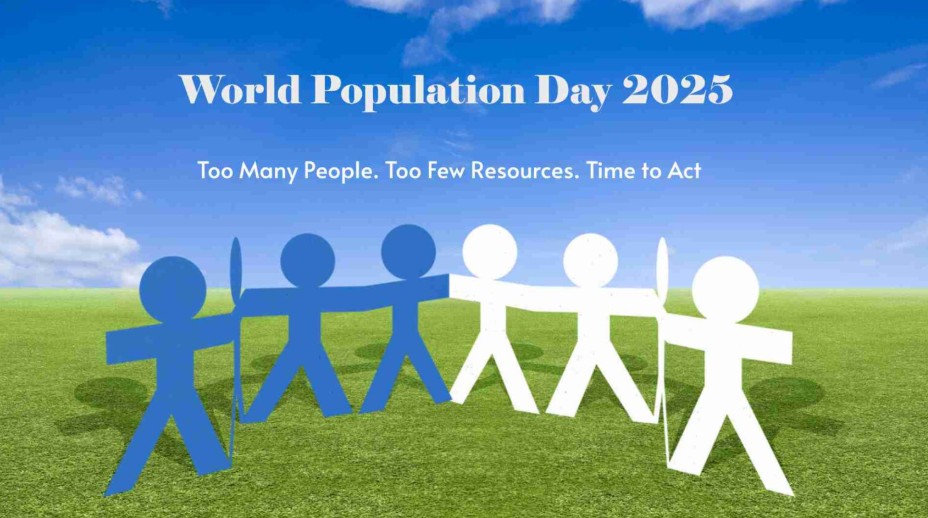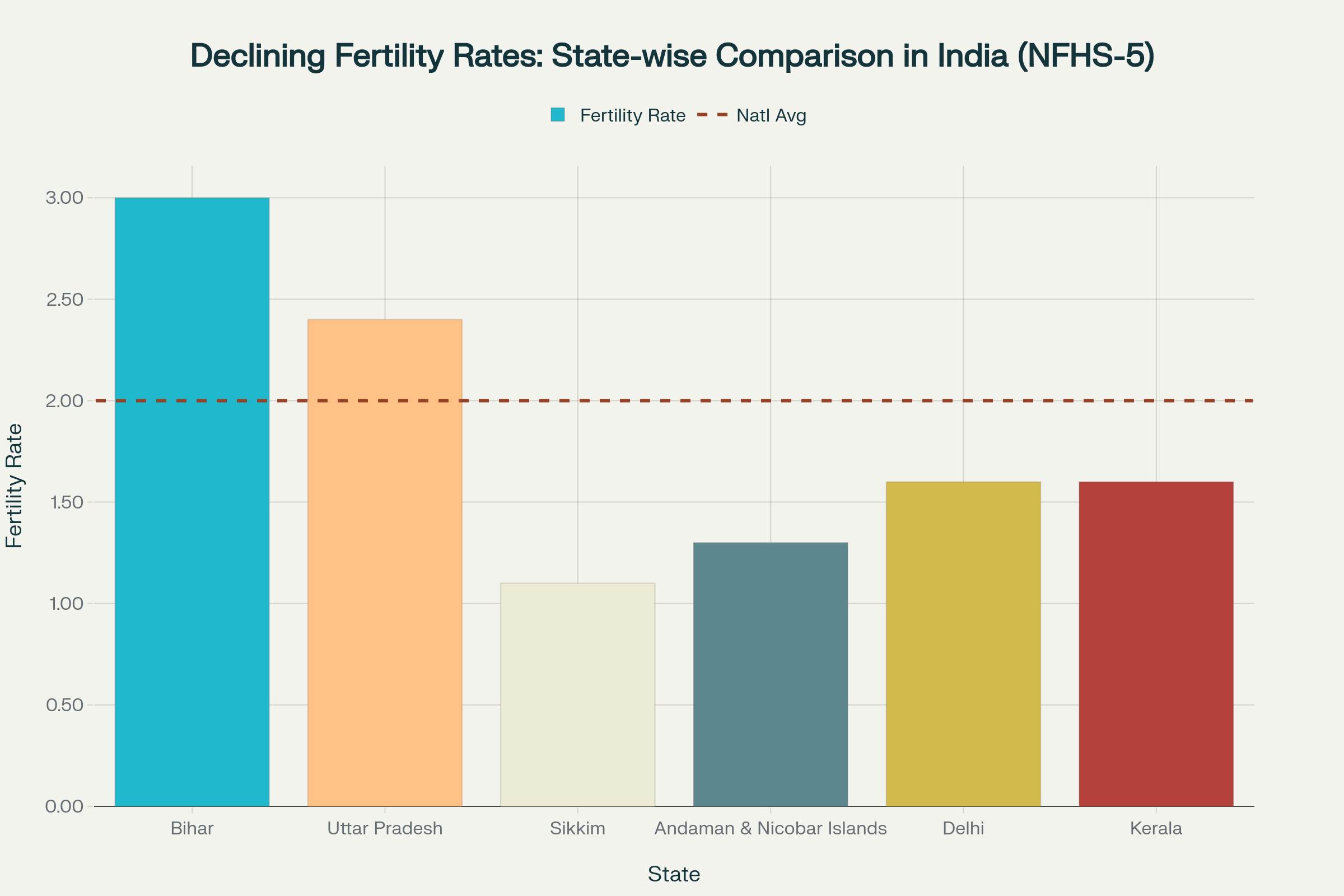
World Population Day 2025 and India’s Youth Empowerment Theme
World Population Day 2025 centers on the theme “Empowering young people to create the families they want in a fair and hopeful world.” This theme is especially relevant for India, where over 26% of the population is aged 10–24. Empowering this vast youth population through education, reproductive health services, and economic opportunities is vital for shaping a sustainable demographic future. The decisions young Indians make today will influence the country’s social and economic trajectory for decades. As Dr. M.S. Swaminathan said, “Population stabilization is not just a number game; it is about people’s well-being and the nation’s future.”
India faces the dual challenge of harnessing its demographic dividend while managing pressures from urbanization, environmental degradation, and regional disparities. World Population Day is more than symbolic; it urges policymakers, civil society, and citizens to collaborate in empowering youth and promoting inclusive growth. This blog explores India’s population dynamics, with calls for action to ensure that the youth have the tools to make informed choices and build equitable societies.
World Population Day: Origins and India’s Role
World Population Day was established in 1989 by the United Nations Development Programme to raise awareness about global population challenges. It commemorates the day in 1987 when the world population reached five billion, marking a milestone that highlighted urgent population-related issues. Since then, it has served as a platform to discuss reproductive health, gender equality, sustainable development, and human rights. India’s demographic journey has been central to this global conversation, given its size, diversity, and rapid growth.
India’s population policies and trends have significantly influenced global population discourses. The country’s experience—from early family planning efforts to today’s rights-based approaches—offers valuable lessons. As former Prime Minister Dr. Manmohan Singh noted, “India’s demographic dividend will be a wasted opportunity unless we invest in education, health, and skill development.” This underscores the importance of integrating population concerns with broader development goals. World Population Day reminds us that population management is about creating conditions for human flourishing, not just controlling numbers.
India’s Population in 2025: Key Facts and Projections
India’s population in 2025 is approximately 1.46 billion, making it the world’s most populous country. The annual growth rate has slowed to 0.89%, reflecting a demographic transition underway. The total fertility rate (TFR) has fallen below replacement level to 1.94, signaling a shift toward smaller family norms. Urbanization is accelerating, with 37.1% of Indians living in urban areas, up from 31% in 2011. These demographic trends have profound implications for economic growth, resource allocation, healthcare, and social services.
Looking ahead, India’s population is projected to peak at around 1.7 billion by the early 2060s before gradually declining. This demographic peak will pose challenges related to resource management, infrastructure, and social equity. Managing this growth equitably across regions is essential, as some states face rapid population increases while others experience stagnation or decline. Tailored policies will be critical to ensure sustainable and inclusive progress.
| Year | Population (Billion) | Fertility Rate | Urban Population % |
|---|---|---|---|
| 2025 | 1.46 | 1.94 | 37.1 |
| 2030 | 1.53 | 1.88 | 39.8 |
| 2040 | 1.62 | 1.80 | 45.9 |
| 2050 | 1.68 | 1.76 | 52.2 |
Source: Worldometer, Census of India
Understanding the 2025 Theme: Youth Empowerment and Family Choice
The 2025 World Population Day theme emphasizes empowering young people to make informed family choices in a fair and hopeful world. India’s youth, forming a quarter of the population, face challenges such as limited access to quality education, reproductive health services, and economic opportunities. Empowerment means enabling youth to exercise agency over their reproductive choices, career paths, and social participation. It also means dismantling barriers like gender inequality, misinformation, and economic uncertainty.
Comprehensive reproductive health education and services are essential to overcome these challenges. Youth participation in policymaking and community engagement is equally critical for creating inclusive solutions. UN Secretary-General António Guterres said, “They are not only shaping our future; they are demanding one that is just, inclusive, and sustainable.” India must heed this call by investing in youth-centric policies that promote equity, opportunity, and hope.
Demographic Dividend: Opportunity or Risk?
India’s demographic dividend, driven by a large young population, offers a unique economic opportunity. With over 26% of the population aged 10–24, India can boost productivity, innovation, and growth if investments are made in education, skill development, and job creation. However, this potential is not guaranteed without proper planning and investment.
Youth unemployment remains a significant challenge, with many lacking skills for the modern economy. If unaddressed, this could lead to social unrest and economic stagnation. Dr. Manmohan Singh warned, “India’s demographic dividend will be a wasted opportunity unless we invest in education, health, and skill development.” Coordinated efforts across sectors are essential to equip youth for meaningful economic participation and to realize the dividend’s full benefits.
Declining Fertility Rates: Implications for India
India’s fertility rate has declined to 1.94, below the replacement level of 2.1, marking a significant demographic transition. However, this decline is uneven across states. Northern states like Bihar and Uttar Pradesh still have higher fertility rates, while southern states such as Kerala and Tamil Nadu have rates well below replacement. This unevenness presents challenges for national planning and resource allocation.
A declining fertility rate eases pressure on resources and improves maternal and child health outcomes. However, it also leads to a shrinking workforce and an aging population in the long term. Preparing for this demographic shift requires strengthening healthcare systems, social security, and pension schemes. Policymakers must anticipate these changes to maintain economic stability and social cohesion in the decades ahead.

State-wise fertility rates in India showing highest and lowest fertility states compared to the national average (NFHS-5 data)
This comparison underscores the urgent need for targeted interventions in high-fertility states while consolidating gains in states with low fertility rates. Policymakers must focus on improving access to family planning, reproductive health education, and social development programs, especially in regions where fertility remains high. The declining national fertility rate is a positive sign, but bridging regional gaps will be crucial for balanced and sustainable demographic progress in India.
Regional Population Disparities
India’s population growth is marked by stark regional disparities. States like Uttar Pradesh and Bihar continue to experience rapid population growth, straining infrastructure, education, and healthcare systems. Conversely, states like Kerala and Tamil Nadu face population stagnation or decline, leading to aging populations and potential labor shortages.
These disparities complicate policy formulation and resource allocation. High-growth states require enhanced family planning services, education, and infrastructure development. Low-growth states must focus on elder care, workforce sustainability, and economic diversification. Tailored, region-specific approaches are essential to address these divergent demographic realities and promote balanced development across the country.
Urbanization and Migration Challenges
India’s urban population has risen to 37.1% in 2025 and is expected to reach 40% by 2030. Urban centers contribute approximately 75% of India’s GDP, underscoring their economic importance. However, rapid urban migration has strained infrastructure and public services, leading to congestion, pollution, and housing shortages.
Urban planning has struggled to keep pace with this growth. While initiatives like the Smart City Mission aim to improve infrastructure and livability, progress remains uneven across cities. Sustainable urban development requires investments in public transport, water supply, sanitation, and affordable housing. Without these, cities risk becoming bottlenecks rather than engines of growth.
| Year | Urban Population % | GDP Contribution % |
|---|---|---|
| 2011 | 31 | 63 |
| 2025 | 37.1 | 70 |
| 2030 | 40 | 75 |
Source: Census of India, Smart City Mission
Family Planning and Reproductive Rights
India’s family planning policies have undergone significant transformation over the decades. In the 1970s, coercive sterilization campaigns sparked widespread public backlash and political upheaval, highlighting the dangers of top-down approaches. Since then, India has shifted to voluntary, rights-based family planning programs that emphasize informed choice, access to contraception, and maternal health services. These programs aim to empower individuals and couples to decide freely and responsibly the number and spacing of their children.
Despite these advances, challenges persist, especially in rural and marginalized communities where access to reproductive health services remains limited. According to NFHS-5, only about 21% of married adolescents not using contraception had contact with health workers recently, indicating gaps in outreach and education. Expanding reproductive health education and strengthening healthcare infrastructure are critical to bridging these gaps. Empowering people with knowledge and services not only supports population stabilization but also improves overall health outcomes, reduces maternal mortality, and promotes gender equality.
Women’s Empowerment and Gender Equality
Women’s empowerment is a cornerstone of sustainable population control and social progress. Educated women are more likely to have fewer children, seek healthcare, and invest in their families’ well-being. Gender equality reduces harmful practices such as early marriage and son preference, which contribute to higher fertility rates and skewed sex ratios in some regions. However, despite progress, many Indian women still face social, economic, and cultural barriers that limit their autonomy and access to reproductive health services.
Promoting gender equality involves multifaceted efforts, including improving girls’ education, enhancing women’s participation in the workforce, and ensuring legal protections against discrimination and violence. Empowered women contribute significantly to economic growth and social stability. As Dr. A.P.J. Abdul Kalam famously said, “Empowering the youth is the key to a developed India.” This empowerment must extend to women and girls, enabling them to make informed reproductive choices and participate fully in society. Addressing gender inequality is therefore essential for India’s demographic and developmental goals.
Environmental Impact of Population Growth
India’s rapid population growth exerts enormous pressure on its natural resources and environment. Water scarcity, deforestation, air pollution, and inadequate waste management are critical challenges linked to overpopulation. India is currently the world’s third-largest emitter of carbon dioxide, with population-driven demand for energy, transportation, and agriculture contributing significantly to greenhouse gas emissions. These environmental stresses threaten biodiversity, public health, and long-term sustainability.
Addressing these challenges requires integrating population stabilization with environmental conservation. Policies promoting sustainable resource use, renewable energy adoption, and climate resilience are vital. Urban areas, in particular, must adopt green infrastructure and waste reduction strategies to mitigate pollution. Public awareness campaigns can encourage sustainable consumption patterns among citizens. Ultimately, balancing human needs with environmental protection is crucial for India’s future prosperity and ecological health.
Ageing Population: Preparing for the Future
India’s demographic transition is leading to a rapidly aging population. Declining fertility rates combined with increased life expectancy mean the proportion of elderly citizens will rise significantly by 2050. This “silver tsunami” presents new social and economic challenges, including increased demand for healthcare services, pensions, and social support systems. Preparing for this demographic shift is essential to ensure dignity and quality of life for older adults.
Policymakers must develop comprehensive strategies for elder care, including expanding geriatric healthcare infrastructure and social security schemes. Community-based support and awareness programs can help address social isolation and elder abuse. Additionally, adapting urban infrastructure to be age-friendly and promoting healthy aging are important components. India’s ability to manage this transition will influence its social stability and economic resilience in the decades ahead.
Historic Population Growth and Urban Planning
India’s historic population growth has profoundly shaped its urban landscape. Rapid migration from rural to urban areas has overwhelmed infrastructure, leading to congestion, inadequate housing, and sanitation challenges. Many cities suffer from sprawling slums, traffic bottlenecks, and environmental degradation. Urban planning has struggled to keep pace with this explosive growth, creating complex governance and sustainability issues.
To address these challenges, initiatives like the Smart City Mission aim to modernize infrastructure, improve public services, and enhance livability. Investments in public transport, water supply, waste management, and affordable housing are critical. Moreover, inclusive urban governance that involves community participation can ensure that development meets the needs of all residents. Sustainable urban planning is essential for transforming India’s cities into engines of economic growth and social well-being.
Role of Reproductive Health Education
Reproductive health education plays a pivotal role in India’s demographic transition. It empowers young people with knowledge about their bodies, contraception, and family planning, enabling informed decisions that lead to smaller, healthier families. Programs like the School Health & Wellness Programme seek to fill knowledge gaps and combat misinformation, especially among adolescents and young adults.
However, access to reproductive health education remains uneven, particularly in rural areas and among marginalized groups. Cultural taboos and lack of trained educators further hinder effective outreach. Expanding comprehensive reproductive health education is essential to sustain fertility decline and improve health outcomes. It also promotes gender equality by challenging harmful social norms and empowering girls and young women to exercise agency over their reproductive lives.
Balancing Population Control and Economic Growth
Balancing population control with economic development is a complex but critical challenge for India. A stable or declining population combined with a skilled, healthy workforce can boost per capita income and living standards. Conversely, unchecked population growth can strain resources, slow economic progress, and exacerbate inequality. Achieving this balance requires integrated policies that simultaneously promote education, healthcare, gender equality, and job creation.
India must create economic opportunities that absorb its large youth population while promoting population stabilization. Investments in skill development, entrepreneurship, and innovation are key to harnessing the demographic dividend. Additionally, aligning economic policies with population goals ensures sustainable development. This integrated approach can help India achieve inclusive growth while managing demographic pressures effectively.
Environmental Impacts of Overpopulation
Overpopulation intensifies resource depletion and environmental degradation in India. Water shortages, air pollution, loss of biodiversity, and climate change impacts are closely linked to population pressure. India’s rapidly growing population increases demand for food, energy, and land, often leading to unsustainable exploitation of natural resources. These environmental challenges threaten public health and economic stability.
Population stabilization must be paired with green policies to reduce ecological footprints. Promoting renewable energy, sustainable agriculture, and efficient water use are vital strategies. Public awareness and behavioral change campaigns can encourage conservation and responsible consumption. Integrating population and environmental policies is essential for long-term sustainability and resilience in India’s development trajectory.
Government Policies and Family Planning History
India’s family planning policies have evolved significantly since independence. The coercive sterilization campaigns of the 1970s led to public distrust and political fallout, highlighting the dangers of heavy-handed approaches. Since then, India has adopted voluntary, rights-based family planning programs focused on education, access, and empowerment. These programs aim to respect individual choices while addressing population growth.
Current initiatives like Mission Parivar Vikas target high-fertility regions with enhanced services and outreach. However, challenges remain, especially in rural and marginalized communities where cultural barriers and misinformation persist. Learning from history is crucial to avoid repeating past mistakes. Empowerment, informed choice, and community engagement remain the pillars of effective population policy in India.
Charting a Sustainable Population Future for India
World Population Day 2025 reminds us of India’s demographic crossroads. Empowering youth and promoting gender equality are essential priorities. Investments in education, healthcare, and urban infrastructure must increase. Environmental sustainability and aging population preparedness cannot be ignored.
Holistic, inclusive policies will shape India’s demographic destiny. As Mahatma Gandhi said, “The future depends on what you do today.” India must act decisively to ensure a fair and hopeful future. Our collective efforts will determine the quality of life for generations to come.
This World Population Day, join the conversation on youth empowerment. Advocate for reproductive rights and sustainable development policies. Support education and healthcare access for all Indians. Together, we can shape a prosperous and equitable India.
#WorldPopulationDay #PopulationControl #PopulationHealth #DemographicDividend #FamilyPlanning
